Not in any league with the Noctilucent clouds but can I include rainbows? They are also caused by solar reflection/refraction on water droplets in the air, right? I do find them fascinating and at least that is something we can certainly get relatively more opportunities to see in London!
Well anyway, so last week, I was strolling out of regents park after a very wet evening cricket match and saw a lovely double rainbow spanning across the park. Dont think I have seen a double rainbow before, at least not as clearly as on that evening. I wished I had my canon and wide angle lens but all I had was my camera phone. So I could only capture part of the rainbow.
Why are rainbows so damn neat and bizarrely out of place as if a mad painter just swiped his multi paint brush in the sky...did Brian mention something about holographic universe? I might need to go check that out again!
And why does it appear in just one position, why not in several? I get that it is an optical illusion and that it has no specific x,y,z coordinates but still, why just the one perceptive position?
Looking at the double rainbow, the colours are reversed on the outer bow. Interesting.
And finally, is there a pot of gold next to that clock tower? 😉

can I include rainbows
Absolutely... fascinating stuff. Great photo!!
In fact, I don't know where to start! There are so many related sky phenomena caused by the Sun (rainbows, halos, sun dogs, green flash, etc), that this thread could go on for a while!
Anyway, I haven't got much time at the moment, so a quick explanation of what I know about rainbows...
Firstly, to predict where a rainbow might occur, stand with the Sun at your back. The rainbow will be centred on the shadow of your head, with the primary rainbow at an angle of 42 degrees between your head and the shadow (the physics of this is fascinating and involves 2 refractions and 1 internal reflection of sunlight within a raindrop) - or, to use the technical term, 42 degrees from the antisolar point.
In order to see a rainbow, therefore, the Sun must be less than 42 degrees above the horizon for the top of the primary rainbow to be above the horizon.
If you are lucky (as you were, Tej), you can see a secondary rainbow. In this case, there are two internal reflections in the raindrop (not one), so the secondary rainbow lies 51 degrees from the antisolar point... so 9 degrees outside of the primary rainbow. That looks exactly right from your picture, Tej. In a secondary rainbow, the bow is around 60% wider than the primary and the spectra is reversed.
Between the primary and secondary rainbows, you have a feature known as Alexander's Dark Band, where the sky is slightly darker than elsewhere. There's not much in it, but it can be seen, as this is an area into which the light from the two rainbows cannot enter.
It was Edmund Halley who first calculated that there should be a tertiary rainbow, but that it would be only 42 degrees from the Sun. Therefore, it is exceptionally difficult to view... as far as I know, it's only been photographed. There is, even, as quaternary rainbow at 44 degrees from the Sun... but again, it's only been photographed and not viewed with the eye, as far as I know.
Oh, and one last thing! The rainbow is not a bow!! It's a conical shell... it just looks like a bow from your perspective. When you move, the rainbow moves... each observer has their own private rainbow! In fact, it is always circular and always has the same angular size (for primary rainbows, an 84 degree diameter, or around one quarter of the entire horizon).
Must stop now... got to work for a living!!
Add to Mike's list a phenomenon known as a Brocken Spectre (note - not broken, but brocken).
Note the completely circular rainbow shape and the shadow of the photographer/viewer! It's most commonly seen when you're high up on a steep mountain and so you can look down on it. I've seen it a couple of times, back when I was nuts enough to go and climb hills in Scotland.
Another reflection, refraction phenomenon is the Halo. I took this picture of a Sun Halo from a sunny Solent last month. Resorting to Wikipedia:
"They are produced by the ice crystals in cirrostratus clouds high (5–10 km, or 3–6 miles) in the upper troposphere. The particular shape and orientation of the crystals is responsible for the type of halo observed. Light is reflected and refracted by the ice crystals and may split up into colors because of dispersion. The crystals behave like prisms and mirrors, refracting and reflecting sunlight between their faces, sending shafts of light in particular direction".
I haven't done the trig. but I assume this is a more common 22deg halo rather than the rarer 46deg halo?
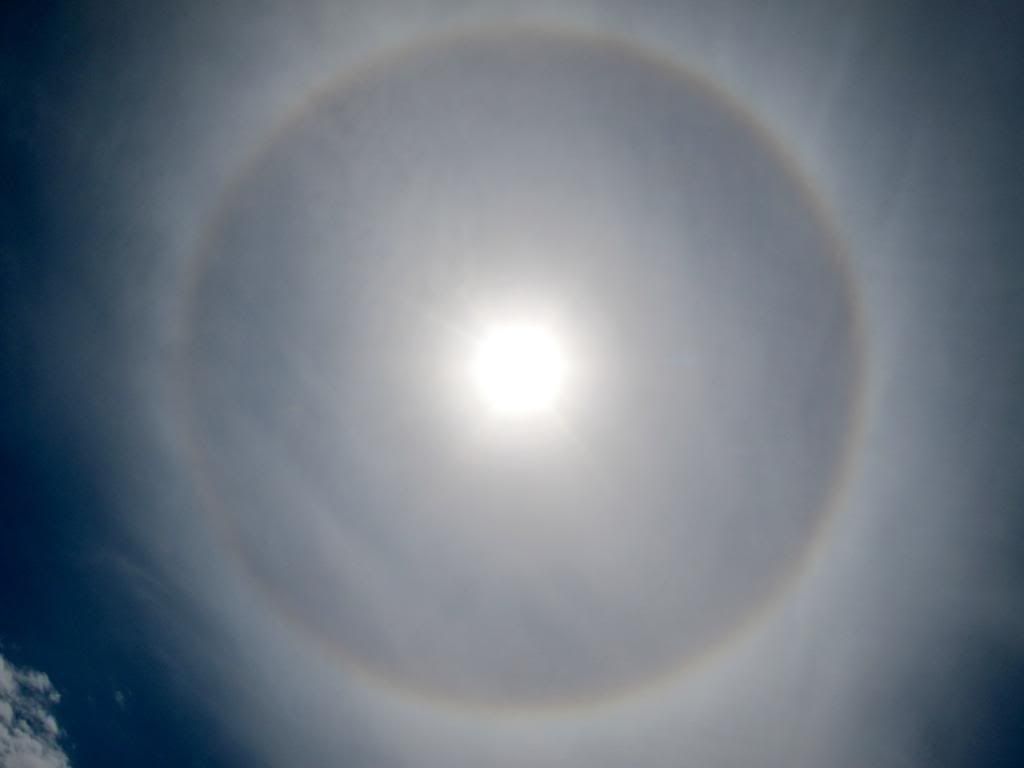
a phenomenon known as a Brocken Spectre
Thanks for this, Andy... you can sometimes see a similar phenomenon from an airplane, surrounding the shadow of the plane on the cloud layer below. Both are examples of a "glory" and are caused by diffraction scattering of light by fog or cloud. It always occurs at the antisolar point (i.e. the opposite side of the sky from the Sun).
Interesting reading the Wikipedia link above that in China it's known as "Buddha's light". If one thinks about religious art in the west, the heads of saints are surrounded by rings or discs of light, which must have been inspired by viewing a glory.
I took this picture of a Sun Halo from a sunny Solent last month
Great picture, Clive. Yes, it does look like the 22 degree halo, based on the size of the Sun in your picture. Still, it's a lovely sight!
Just to add to the list of sky phenomena, I thought I'd add my own contribution... Sundogs. This is a picture I took at sunset in Whitstable a couple of years ago:
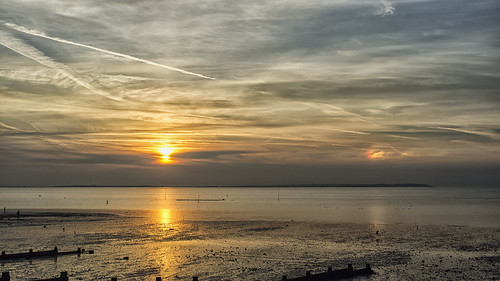
Sundogs may appear singly or in pairs (either side of the Sun) and lie at 22 degrees from the Sun. They can also be accompanied by a 22 degree halo. They often display a hazy spectrum, with red on the sunward side (as in my picture).
There's still a few sky phenomena to mention, but I won't hog the discussion!
Mike, perhaps you can you change the thread title to Sky phenomenons (UFOs excluded).
Great picture, Clive, and Mike, well done with your sundog!
Are the probabilities of those sort of phenomenon dependant on type of location. Are there chances of seeing those from London?
Mike, I reckon you'd make a lot of money selling photographs like that. Then you'd be a sundog millionaire.
I'll get my coat...
Topic renamed.
Mike the halo around saints head is due to the merging of sun worship with the early Christianity of Paul who change it's ethos so as to make it more palatable for non Jewish people. This was so as to get the Roman empire to adopt it as the state religion. The worship of the sun would certainly be enhance by seeing Glory.
Double sun dogs..
Great photo... looks like there is a 22 degree halo just visible as well.
Right, it's time to add a couple more sky phenomena!
First of all, "Pillars". These normally occur in cold weather when the Sun or the Moon is just about to set (sometimes just after the Sun or Moon has set) and is caused by reflection of light off of the flat surfaces of ice crystals or snowflakes. A quick search on Flickr has turned up this stunning example:
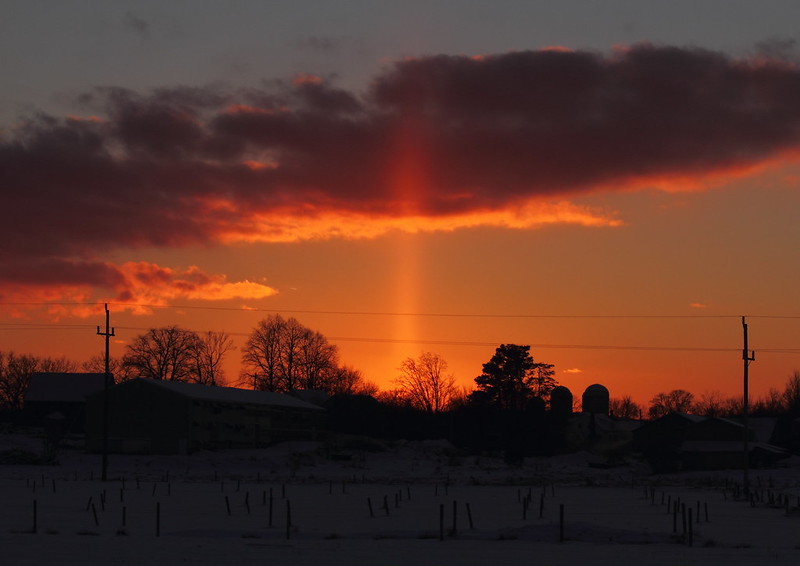
by Flickr user Claire J, taken from Canada.
And, my last one, "The Green Flash". For any object in the sky, the amount of refraction increases near to the horizon... that's why, when we see the Sun or Moon near the horizon, they appear slightly "squashed". Refraction also varies with the frequency of light, with the least amount of refraction for red light and the most for violet. Therefore, at sunset, as the top part of the Sun starts to dip below the horizon, the red part of the spectrum is dispersed first. As the violet and blue light is already removed through atmospheric scattering (which is why sunsets appear red), the only colour left is green. This can sometimes be seen, for no more than a second, as a "green flash" at the top of the Sun.
I've never seen one, only in photographs, as they are tricky to image. It's also quite dangerous, as you can be looking directly at the solar disc... never, ever do this with an optical aid (telescopes or binoculars), unless you want a fried retina! If you have an old camera, you can probably risk using it to image a green flash. Again, a quick search on Flickr gave me this:
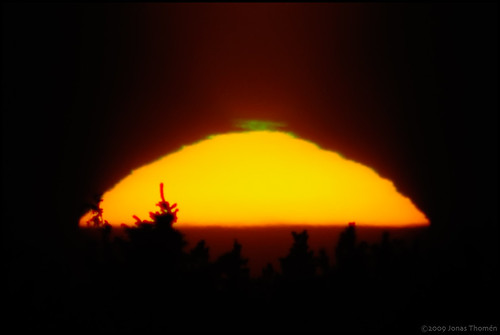
Image by Jonas Thomen.
I can't think of any other sky phenomena, though I'm sure I've missed some!
Just spotted this on Twitter: rainbow/glory on Venus.
http://www.popsci.com/article/science/big-pic-alien-rainbow-venus?src ="SOC&dom=tw"
Wow, great photos of rainbows, sundogs etc.
Here my contribution of sundogs!
 IMG_3537.jpg by Sumitra_S, on Flickr
IMG_3537.jpg by Sumitra_S, on Flickr
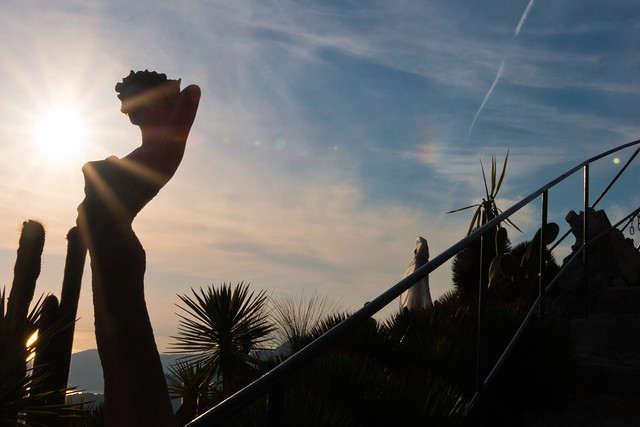 IMG_3565.jpg by Sumitra_S, on Flickr
IMG_3565.jpg by Sumitra_S, on Flickr
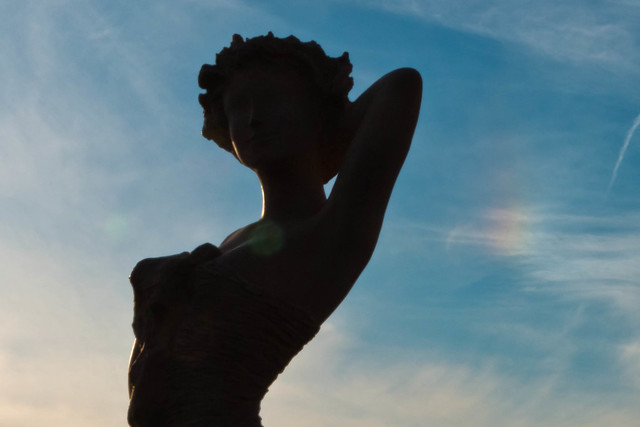 IMG_3564.jpg by Sumitra_S, on Flickr
IMG_3564.jpg by Sumitra_S, on Flickr
Here my contribution of sundogs!
Very nicely composed images.
Forgive me for saying... and you've probably learnt this by now... by stopping down to f/22, you have lost some sharpness in the image due to lens diffraction. It may have been better to use f/11, or thereabouts... though I appreciate that you are shooting into the Sun, so it's difficult to open the aperture more! I'd tend to use an ND filter in these circumstances, just to ensure that the image is sharper.
There is a good explanation of lens diffraction here, which you may find useful.
Forgive me for saying… and you’ve probably learnt this by now… by stopping down to f/22, you have lost some sharpness in the image due to lens diffraction. It may have been better to use f/11, or thereabouts… though I appreciate that you are shooting into the Sun, so it’s difficult to open the aperture more! I’d tend to use an ND filter in these circumstances, just to ensure that the image is sharper.
Glad you like them and feedback always welcome, Mike!
I was at F/22 to have a spiky sun, which is when I saw the Sundog and took more photos. Do you know if I could still have had a spiky sun at F/11 in daylight? I can't remember for sure, but I think I'd tried going up from F/7 onwards.
I do still have your email on the filters when I had wanted to buy one - I need to replenish the penny jar before I can afford one you suggested... But it's on the list with a faster lens 🙂
Sadly my Sigma lens seems to have a problem with a stuck aperture at the moment (I've noticed online that it's a common thing). It doesn't seem to close any more and some of my photos end up over exposed. I need to try and see if I can get it repaired soon.
There is a good explanation of lens diffraction here, which you may find useful.
Many thanks! I'll have a look!
Incidentally, do you think we could build a sort of list where forum users can post useful links they found, like the one you put here, the one I found for ETTR and the Milky Way and others?
